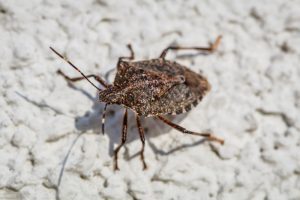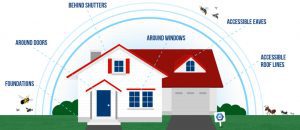STRANGE INDOOR BUGS IN EARLY SPRING?
By Chris Williams on February 26, 2019.
Last spring we had a problem with some kind of creepy pine tree seed bugs (we were told) in our home while there was still snow on the ground outside! Eventually they went away but I’m wondering if the same thing is going to happen this year. I don’t know how they’re getting in.
L. W., Durham NH
I suspect that the bugs you are seeing in early spring did not just wander in from outside. They’ve been in your house all winter. It sounds like your visitors could be western conifer seed bugs. These fairly large (3/4-inch) bugs feed on pines, spruce, firs, and hemlock trees. They are reddish-brown and their hind legs have an expanded leaf shape near the base (see Seed Bugs Would Like to Spend the Winter in Your Home!). They are usually not noticed outdoors but in the fall they move into protected places to spend the winter…and that often means nearby homes.
WESTERN CONIFER SEED BUGS WILL MOVE INSIDE
In late summer, the bugs collect on sunny, exterior walls and eventually find their way in through openings around the roofline and doorways, etc. Once inside, they go into hiding for the winter and often aren’t seen again until spring or a warm, sunny day in winter when they might come out of hiding looking for a way back outside.
Be careful if you vacuum up any wandering seed bugs because they can give off an unpleasant defensive odor. If you have a large number indoors, a pest control company can treat if the bugs are out in the open. Trying to kill them when they are hiding in random locations is not feasible.
LET COLONIAL PREVENT NEXT YEAR’S FALL INVADERS
The best way to control western conifer seed bugs is an advance attack: a combination of pest-proofing to eliminate openings into your home, and a timed exterior insecticide treatment to kill them as they gather in the fall but before they can get inside. At Colonial Pest, we offer both of these services. Most of our customers take advantage of our Preventative Maintenance Program that offers year-round pest protection.

Brown Marmorated Stink Bug. Shutterstock.
Whether you will see these bugs indoors again this year depends on many factors, mostly what happened outside the previous summer. Since the bugs feed on the cones and seeds of conifers, their abundance is tied to the success of the trees. If it was a good year for conifers with lots of cones produced, it was probably a good year for seed bugs. On the other hand, weather extremes could have affected seed production or the offending pine trees near your house may not even be there anymore.
WE OFFER YEAR-ROUND PEACE OF MIND
In any case, we recommend our Preventative Maintenance Program because it targets many types of pests that live around the foundation of your home and would like to find their way inside. We automatically visit your home twice a year, timed to coordinate with pest activity. You don’t even have to be home since our work is done outside to prevent pests inside. The annual service also includes unlimited free callbacks should a pest problem arise.
 Western conifer seed bugs are just one type of plant-feeding insect that can overwinter hidden in your home (see Why Are There Plant Bugs in My House?). Fortunately, like the others, western conifer seed bugs don’t bite people or feed or reproduce indoors. But they can fly. To prevent a reoccurrence next year, call Colonial Pest and ask us about our professional pest exclusion measures that seal openings and gaps that let pests inside.
Western conifer seed bugs are just one type of plant-feeding insect that can overwinter hidden in your home (see Why Are There Plant Bugs in My House?). Fortunately, like the others, western conifer seed bugs don’t bite people or feed or reproduce indoors. But they can fly. To prevent a reoccurrence next year, call Colonial Pest and ask us about our professional pest exclusion measures that seal openings and gaps that let pests inside.